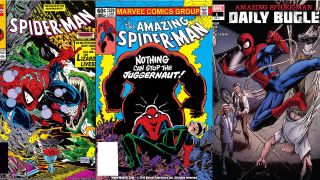Since 1962, there have been plenty of contenders for this best Spider-Man artists list. Steve Ditko created the character alongside Stan Lee back in the day, but since then we've had plenty of wonderful artists like Todd McFarlane, both John Romita Sr. and Jr, and more. Spider-Man is a world famous character and these are the best Spider-Man artists of all time.
10. Ross Andru

Although his name may not have the glitz and glamour that Steve Ditko, Mark Bagley, or Todd McFarlane have accumulated, the first-generation Russian-American Ross Andru is for many people the definitive Spider-Man artist of their youth.
Trained by Burne Hogarth, Andru had a long career penciling newspaper strips and across town at DC before he made his Marvel debut. It came in 1968 when he was brought in at the last minute to do a fill-in issue of Amazing Spider-Man for John Romita Sr., who had injured his wrist. Romita recovered sooner than expected, and Andru’s Marvel debut was shifted over to Marvel Super-Heroes #14. But Marvel saw something in Andru, and put him to work doing work for Marvel Feature and Marvel Team-Up, the latter of which featured Spider-Man in many of its stories.
In 1973 Andru got his proper debut on Amazing Spider-Man, doing what turned into a five-year run on the title including penciling the debut of the Punisher. As arguably Marvel’s top artist at the time, Andru was tapped to illustrate the rare company crossover Superman vs. Amazing Spider-Man in 1978 with writer Gerry Conway, whom he collaborated frequently with.
Andru’s work epitomized Spider-Man in the 1970s, and his attention to detail on things like the New York skyline and backgrounds made him a real artist’s artist among creators at the time. Whereas John Romita Sr.’s skill came in his past as a romance artist, Andru was a versatile illustrator and able to bring in horror, western and straight-up superhero flavor to the character allowing the writers he worked with to do more diverse stories.
9. Humberto Ramos

Mexican artist Humberto Ramos is part of the crew that redefined Spider-Man and killed Peter Parker in Superior Spider-Man (and eventually brought him back). Whether you enjoyed SpideyOck or not, you have to give respect for the massive contributions Ramos has made to the wall-crawler’s history.
Born in Mexico in 1970, Ramos studied under the father-son duo of Oscar González Guerrero and González Loyo and rose up the ranks in comic books pretty quick. After debuting for DC/Milestone’s Hardware in 1993, Ramos did an impressive run on Impulse and then Marvel’s X-Nation 2099. Ramos’ first shot on Spider-Man was a unique one, as he was tapped to illustrate a cover for Spider-Man 2099. Ramos would eventually take a break from the Big Two and superheroes all together, as he was head-hunted by Wildstorm to be a part of their “Cliffhanger” line and went on to create his own books like Crimson and Out There.
But Ramos couldn’t keep away from Spider-Man, and his return to the Big Two in 2001 became official when he was asked to become the cover artist for the series Peter Parker: Spider-Man. After 13 covers, was pulled in on a full-time basis when he and Paul Jenkins brought back the Goblin in the “A Death In The Family” arc. After that, he and Jenkins were given their own series in 2003 with Spectacular Spider-Man and giving Ramos his first chance at Venom, whom he’d become very well-known for. After 13 issues on that title, Ramos took a break from wall-crawling and did stints on various X-Men and Avengers titles, but was once again drafted into Spidey duty joining the “Brand New Day” team with Amazing Spider-Man #648. For three years, Ramos lived and breathed Spider-Man, working non-stop alongside writer Dan Slott who remains on the series.
Although some might denounce Ramos’ work for it’s more dynamic and cartoonish style, it fits the personality and the antics of the Spider-Man concept and gives the character a kinetic energy that is sorely needed.
8. Marcos Martin
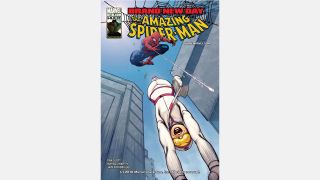
When Marvel turned the page on Peter Parker and launched into Amazing Spider-Man and “Brand New Day,” people were understandably reluctant about what to expect. But as the dust settled, one of the things that won fans over was the art of Marcos Martin.
The Spanish artist had done little work for Marvel leading up to his debut on Amazing Spider-Man #559, but when he landed there it was like magic. Partnering with Dan Slott, Martin channeled Steve Ditko in terms of page layouts but an even older, Milt Caniff-like style for rending his figures – and it was just what the title needed. Due to the thrice-monthly shipping schedule of Amazing Spider-Man during this time he couldn’t rank up the uninterrupted run like other artists on this countdown, but between his ten full issues and his numerous back-up stories in the title he achieved a rare synergy with a character that made it like magic every time an issue of his hit.
Of all the artists on our Countdown today, Martin’s contributions are the smallest in terms of page count. But what he doesn't have in quantity he made up for in his fluid linework and expert handling of Parker, Mary Jane and others that made his time on Spider-Man truly memorable.
7. Ron Frenz

How do you become a memorable artist? Draw a memorable story, and Ron Frenz did just that when he illustrated Roger Stern’s “The Kid Who Collects Spider-Man” for Amazing Spider-Man #248. The un-assuming back-up story easily overpowered the lead feature, giving an Will Eisner-style human interest story which Frenz handled like an expert.
The Pittsburgh-born artist’s association with Spider-Man started very early on in his career; with just one year under his belt he was given a shot at the wall-crawler in drawing 1983’s The Spectacular Spider-Man #80 with a great Bill Mantlo story about how J. Jonah Jameson sees himself in the community. That earned him points with editors, who then put him on the main Amazing Spider-Man title a year later and worked with Stern, Tom DeFalco and other writers in what became a three-year run on the title. During that run Frenz drew the aforementioned “The Kid Who Collects Spider-Man” story as well as the story in which Spider-Man’s black costume is revealed to be a symbiote. Frenz’ take on Spider-Man leaned closer to the character’s original artist Steve Ditko than anyone before him, creating a wiry and idiosyncratic wall-crawler that was far from the beefy jock some artists drew him as.
After his run on Amazing Spider-Man ended in 1986, Frenz went on to co-create characters like the New Warriors, Spider-Girl, and Thunderstrike. Frenz did return to Spider-Man from time to time on various things such as the Spider-Man: Hobgoblin Lives miniseries and more recently on Amazing Spider-Man Family.
6. Erik Larsen
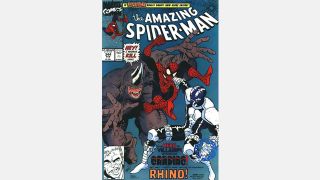
Whereas Todd McFarlane’s run on Amazing Spider-Man and Spider-Man was identified for its darker storytelling and constricted linework, the man who followed him, Erik larsen went back to the roots of the character – to Ditko, and even Kirby - and brought it to the modern age.
After spending years on the independent comic book scene, Larsen launched himself into mainstream comic books with an energetic young style that found him paired with various teen heroes and team books like Teen Titans, The Outsiders and Doom Patrol. After Marvel noticed his work, they quickly slotted him in on a high-profile assignment – doing a fill-in issue of Amazing Spider-Man in 1987. After that the Minnesota-born artist continues to do smaller projects at DC and Marvel including a run on The Punisher before becoming the right artist at the right time when McFarlane left Amazing Spider-Man. Larsen took the series with vigor, quickly breaking from McFarlane’s signature look into a more colorful and dynamic look that leaned on Larsen’s expert storytelling chops to create some complex but easily readable scenes. After 30+ issues on the title, Larsen once again took over for McFarlane – this time on Spider-Man. Larsen then stretched his wings as a writer and artist, creating the great “Revenge of the Sinister Six” arc.
Unlike McFarlane, Larsen ended up returning to Spider-Man on several occasions even while doing his own Savage Dragon series. Larsen drew several guest issues of Peter Parker: Spider-Man and Amazing Spider-Man years later, and even contributed to the anthologies Spider-Man Unlimited and Spider-Man Family.
5. Todd McFarlane

None can argue Todd McFarlane is the best-selling Spider-Man artist of all time. Although derided by some these days for his antics outside of drawing comic books, McFarlane’s contributions to the Spider-Man character are iconic, layered and intricate – just like his Spider-Man issues.
Todd McFarlane came into comic books after his life-long aspirations of being a baseball player were nixed with career-ending ankle injury in college, forcing him to lean on his back-up plan: comics. While working in a comic store to pay his bills, McFarlane began to furiously submit to all the major comic companies at the time, which led to his samples being passed around the Marvel offices. McFarlane got his debut in a backup story in the creator-owned series Coyote which was published by Marvel’s Epic line, then began bouncing around DC and Marvel doing a year on Incredible Hulk, two years on Infinity Inc. and the second half of DC’s “Batman: Year Two” storyline in Detective Comics. But all of that was a precursor for what came next.
When he joined the Spidey line with 1988’s Amazing Spider-Man #298 his intricate, tortured, and dark linework went off like a gunshot in the minds of comics fans. He became well-known for his hyper-detailed illustrations, especially of Spider-Man’s webbing, and went on to define the look of one of the most popular new characters of the 1990s – Venom. Two years into his run, Marvel saw so much in the artist they gave him the reigns of a new title -- Spider-Man -- and let the artist both write and draw his work, a rarity for Marvel and especially for the Spider-Man character.
Spider-Man #1 went on to sell 2.5 million copies in single issues, kickstarting the 1990s comics book boom and beginning a sea change in the industry in terms of artist’s recognition in comics. McFarlane continued to work on the title for 16 issues but the writer/artist bailed on the title at the height of its popularity in order to launch his own series, Spawn.
Since 1993 McFarlane hasn’t done any major work on Spider-Man or at Marvel despite frequent overtures by the publisher to bring him back on a prestige book with Kevin Smith in the early 2000s.
4. John Romita, Sr.
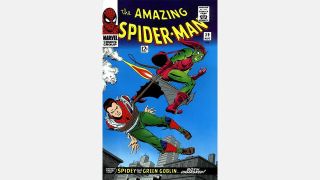
How do you follow in the footsteps of a legendary artist? You don’t. Just ask John Romita, Sr.
When Steve Ditko abruptly quit working for Marvel after Amazing Spider-Man #38, Stan Lee and the Marvel staff were at a loss for where to turn to find a suitable replacement. But they found their man in the veteran comics illustrator John Romita, Sr. – even though he had been trying to quit drawing comic books for years. Although he had qualms about doing it, Romita said he joined the book to be “a good soldier” for the company and didn’t actually settle into the book until six months after he started.
Owing to his decade-long tenure as a romance artist for DC Comics, Romita’s rendition of Spider-Man had more of a curved line – both for Peter Parker, as well as the memorable Mary Jane Watson. Romita’s more confident linework catapulted Spider-Man from being a hot new book to being cemented as the publisher’s flagship title, with Romita’s rendition of Spider-Man being used on the company’s fledging licensing efforts.
Romita went on to draw Amazing Spider-Man, the Spectacular Spider-Man magazine and even the Spider-Man newspaper strip. In the late 80s he returned to the character, drawing guest stories in various Spider-Man publications and was even brought in to draw the end scene of the celebratory Amazing Spider-Man #500 in 2003.
3. Mark Bagley
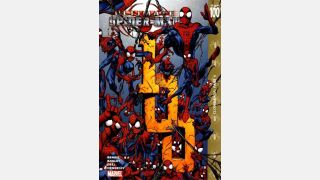
Some people say you can’t come home again, but for Mark Bagley Spider-Man is the home fans hope he never leaves.
Trained as a technical illustrator, Mark Bagley got his break when he won the contest in the back pages of the fondly-remembered Marvel Try-Out Book. While it seems like a no-brainer in hindsight, the House of Ideas didn’t put the Ringling grad straight onto their most popular titles; instead he cut his teeth on a variety of licensed and second-tier books for the publisher, as well as doing Marvel trading cards. Bagley did get some early work in on Spider-Man however, illustrating stories of the character in various annuals, an issue of What If…? and a forgettable arc on Web of Spider-Man. It took to years for Bagley to come into his own –and he did it with style, teaming up with Tom DeFalco on the new teenage superhero team The New Warriors. Bagley’s work there was a positive revelation for fans who found it on the crowded shelves of 1990, and after 25 issues Marvel gave the contest winner his chance to really make his name and meet his destiny.
Beginning with Amazing Spider-Man #345 in 1991, Bagley stepped into the big shoes of departing artist Erik Larsen and carved out a legacy in 64 back-to-back issues. Bagley’s work quickly became a bright spot in the relatively dour times artistically for Mavel at the time, becoming Spider-Man’s definitive artist of the era. Bagley’s rendition of Spider-Man was seen everywhere from comic books to plastic cups and even credit cards as the licensing division took to his work with aplomb. After five years on the title Bagley left that plush assignment for a change of pace, co-creating Thunderbolts with Kurt Busiek. Although he stayed with the Thunderbolts title for several years, Bagley continued to moonlight from that book doing various Spider-Man projects in and around the company.
In 2000 when Joe Quesada and Bill Jemas took over Marvel, industry pundits thought they were throwing out the old in favor of the new, but in Bagley’s place they knew they had a keeper. Bagley was tapped to work with then up-and-coming writer Brian Michael Bendis to carve out a new era for Bagley’s most well-known character and they did just that with Ultimate Spider-Man. Although Bagley initially intended to only do the first arc, he ended up staying for seven issues and drawing 111 un-interrupted issues on the title – a record in superhero books.
Bagley’s take on Spider-Man was more constrained than his predecessors in McFarlane and Larsen, but his consistency and ability to fashion dynamic scenes that didn’t overpower the reader mad him an ideal illustrator for Spider-Man. And the fact that he’s done not one but two epic runs on the character, the latter of which saw him continue to innovate, makes him a shoe-in for this ranking in our Countdown. This version has been on various licensing products and merchandise, including its own video game. No other Spider-Man comic book version has ever had a game where the graphics were based on the comic book art, except Ultimate Spider-Man.
2. John Romita, Jr.
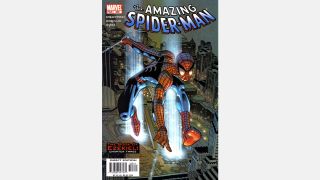
It’s tough living up to people’s expectations – look at all the various stand-ins for Spider-Man that never really cut the mustard. But artist John Romita Jr. has lived up to his father’s legacy and then some, especially with Spider-Man.
Born in New York City in 1957, the younger Romita made his comic book debut at the age of 21, penciling a back-up story in 1977’s Amazing Spider-Man Annual #11. Although Romita would go on to create defining works in everything from Iron Man to Dazzler to Uncanny X-Men in his young career, he quickly became known for his work on Amazing Spider-Man with Roger Stern in the early 1980s. After that, Romita Jr. branched out into more darker fare when he was sent to Hell’s Kitchen to work on Daredevil with Ann Nocenti and later Frank Miller, then working on virtually all corners of the House of Ideas from the Punisher to Thor, Iron Man, and even a Punisher/Batman crossover.
In the mid-1990s however, Romita Jr. returned to the wall-crawler doing issues of both Amazing Spider-Man and Spider-Man, and was the sole artist who was kept on the title after Joe Quesada and Bill Jemas decided to revamp Spider-Man’s titles in 2001. Then, paired with Babylon 5 creator J. Michael Straczynski, Romita’s work was seen in a new light and Romita reached his pinnacle in terms of Spider-Man.
Although Romita Jr. has gone on to create Kick-Ass with Mark Millar and do memorable runs on Wolverine, Avengers and most recently All-Star Batman, he will now and forevermore be best known for his work on Spider-Man.
1. Steve Ditko

Just because you create a character doesn’t mean you’re the best artist who’ll ever illustrate it. But when you look at the work Steve Ditko turned in over three years and 41 issues, all you can do is sit back and go “wow!”
Steve Ditko wasn’t the first guy Stan Lee had in mind to flesh out the idea he had for these teenage spider-based character. It was only after Lee didn’t like Jack Kirby’s designs for his character that he turned to Ditko, who was originally just going to be the character’s inker, to flesh out the idea. And flesh out he did, taking Lee’s name of “Spider-Man” and creating not just the character’s trademark look, but also his webshooters and wall-crawling abilities. And in the ensuing 40 issues, Ditko created the looks for much of the character’s ensemble cast from Aunt May, J. Jonah Jameson and Gwen Stacy to Green Goblin, Doctor Octobus, Electro, The Lizard and the Sandman.
With Amazing Spider-Man #25, Ditko can receiving credit for the plotting he had be doing on the series in addition to drawing the art. Ditko’s decision-making in breaking down Stan Lee’s synopsis of each story focused on the character’s troubled home life, showing a hero who suited up not to just save people but to also attempt to get away from his real world problems. Arguably the pinnacle of Ditko’s run on Spider-Man was 1996’s Amazing Spider-Man #33, showing Spider-Man trying to emerge from beneath the fallen rubble of machinery while fretting over his beloved Aunt May and being guilt-ridden over the death of his uncle.
Unlke Kirby or the artists that would follow him on Amazing Spider-Man, Ditko’s work didn’t show a dashing heroic savior of men; instead it was a lanky teenager with an almost Kafka-esque brooding quality. Ditko’s page design was compact and enterprising, frequently using 6- and 9-panel grids to get across an amazing amount of story in only a few amount of pages. While his contributions on Spider-Man are nearing on the half-century mark, they stand up and over anything that’s come since.
